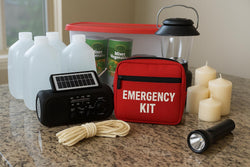Tempramed Blog
What you need to know about DKA (Diabetic Ketoacidosis)

Diabetic Ketoacidosis (DKA) stands as one of the most severe complications of diabetes, primarily affecting individuals with T1D but occasionally surfacing in those with T2D. This metabolic disturbance, marked by elevated blood sugar levels, ketone accumulation, and acidosis, demands swift recognition and intervention to prevent life-threatening consequences. Let’s explore the nuanced symptoms of DKA, underlying causes, diagnostic procedures, and some comprehensive therapeutic approaches.
Understanding Diabetic Ketoacidosis
DKA is a serious complication of diabetes that occurs when your body produces high levels of blood acids, known as ketones.
DKA primarily develops when the body cannot use sugar (glucose) as a fuel source because there is no insulin or not enough insulin. The body then breaks down fat as an alternative source of fuel, which produces ketones. When ketones build up in the blood, they make it more acidic.
Ketone Accumulation: Ketones, namely, acetone, acetoacetate, and beta-hydroxybutyrate, all accumulate in the blood thereby leading to the acidification of blood, the ketosis, and alteration of the acid-base neutrality of the body.
Triggers and Precipitating Factors: DKA can be the result of inflammatory or unbalanced conditions that can be brought about by various factors such as missed insulin doses, spoiled or ineffective insulin, illness or infection, traumatic events, medication non-adherence, as well as undiagnosed diabetes.
Symptoms and Clinical Presentation
Identifying the characteristic signs and symptoms of DKA is pivotal for timely intervention and management:
- Hyperglycemia: Failure to maintain adequate blood glucose levels, i.e., above 250 mg/dL, results in a chronic condition, a hallmark feature of DKA.
- Polyuria and Polydipsia: The body responds to this excess glucose and ketones by constantly signaling frequent thirst and urination as the kidneys try to eject these toxic substances from the body.
- Gastrointestinal Symptoms: Nausea, vomiting, and abdominal pain are mostly seen in DKA, signifying overall metabolic disorder.
- Respiratory Distress: Rapid, deep breathing at a consistent pace (Kussmaul breathing) allows the body to combat acidosis in the cells; this type of breathing features deep, rapid gasps, seeking to balance the organism's internal state.
- Fruity Breath Odor: A special ketonemia smell that's unique, which has been likened to a combination of acetone and nail polish remover.
- Generalized Weakness and Fatigue: Severe tiredness coupled with different symptoms which include stabilization may integrate an overall feeling of weakness as the cells become energy depleted.
Diagnostic Evaluation
Diagnosing DKA entails a comprehensive assessment encompassing clinical evaluation, laboratory investigations, and imaging studies:
- Blood Tests: Taking and confirming the level of blood glucose, ketones, electrolytes such as sodium, potassium, and bicarbonate, the severity of acidosis regarding renal function, and arterial blood gases helps establish the diagnosis and the level of severity of acidosis.
- Urine Analysis: The urine test (Urinalysis) shows ketonuria, proving the presence of ketone bodies in urine.
- Imaging Studies: Imaging techniques like chest X-rays may be employed to assist in evaluating pulmonary problems or inherent conditions with complications.
Management Strategies
The management of Diabetic Ketoacidosis (DKA) involves a series of clinical interventions aimed at correcting the high blood glucose levels, acidosis, and electrolyte imbalances. Here's a breakdown of the primary strategies:
- Fluid Replacement: The first step is to restore fluid balance to counteract dehydration. Patients are administered intravenous fluids to replace lost fluids and to dilute the excess glucose in the blood.
- Insulin Administration: Insulin is administered to reduce blood glucose levels by enabling glucose uptake into the cells. This helps to stop ketone production and allows the body to use glucose for energy again.
- Electrolyte Replacement: Electrolyte imbalances, especially low levels of potassium, are common in DKA. It's crucial to monitor and replenish electrolytes to maintain heart, muscle, and nerve function.
- Monitoring: Continuous monitoring of blood glucose and ketone levels, as well as electrolyte levels and overall patient status, is essential to adjust treatment as needed and to avoid complications such as hypoglycemia (low blood sugar) or hypokalaemia (low potassium).
- Treating the underlying cause: Besides addressing the symptoms of DKA, it's important to identify and treat any underlying causes or triggers, such as infections, that might have led to the development of DKA.
- Education and Prevention: After recovery, educating the patient on managing their diabetes and their insulin effectively to prevent future episodes of DKA is crucial. This includes insulin management and insulin protection from extreme temperatures, monitoring blood sugar levels, and recognizing the early signs of DKA.
These strategies require careful implementation by healthcare professionals in a hospital setting, often in an intensive care unit, to ensure the safety and recovery of the patient.
Conclusion
Diabetic Ketoacidosis (DKA) is a serious challenge in healthcare. It requires quick identification, careful treatment, and constant monitoring to prevent serious outcomes. By ensuring that healthcare providers, people with diabetes, and their caregivers understand DKA well, and recognize the signs, we can work together to improve treatment results, reduce sickness and death, and help people manage diabetes better. By educating, preventing, and actively managing DKA, we aim to lower its occurrence and effects, promoting better health and quality of life for those with diabetes.
References
American Diabetes Association: https://www.diabetes.org/diabetes/complications/dka-ketoacidosis-ketones
Mayo Clinic: https://www.mayoclinic.org/diseases-conditions/diabetic-ketoacidosis/symptoms-causes/syc-20371551
Lizzo JM, Goyal A, Gupta V. Adult Diabetic Ketoacidosis. [Updated 2023 Jul 10]. In: StatPearls [Internet]. Treasure Island (FL): StatPearls Publishing; 2024 Jan-. Available from: https://www.ncbi.nlm.nih.gov/books/NBK560723/




